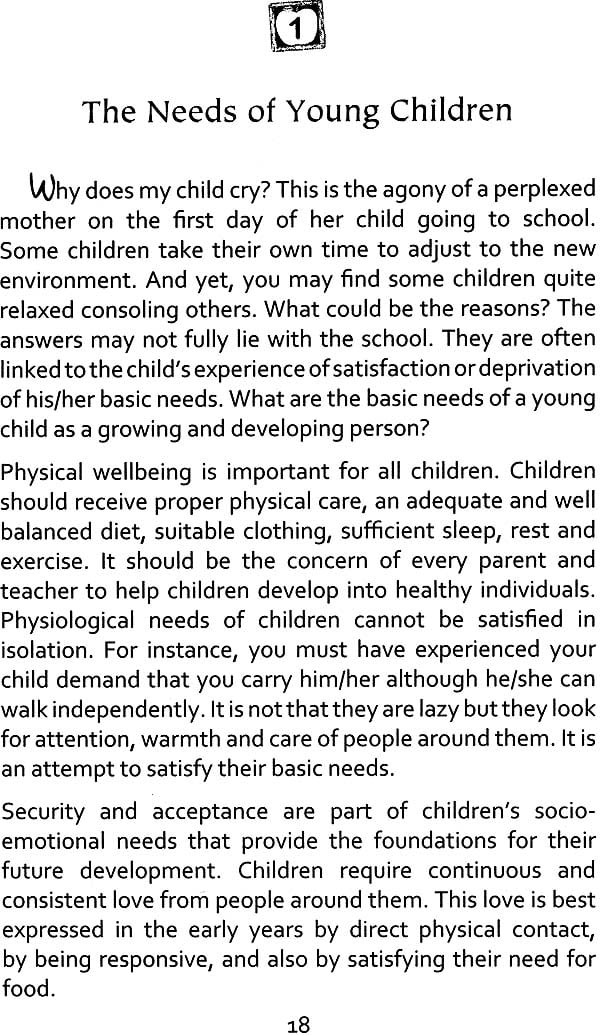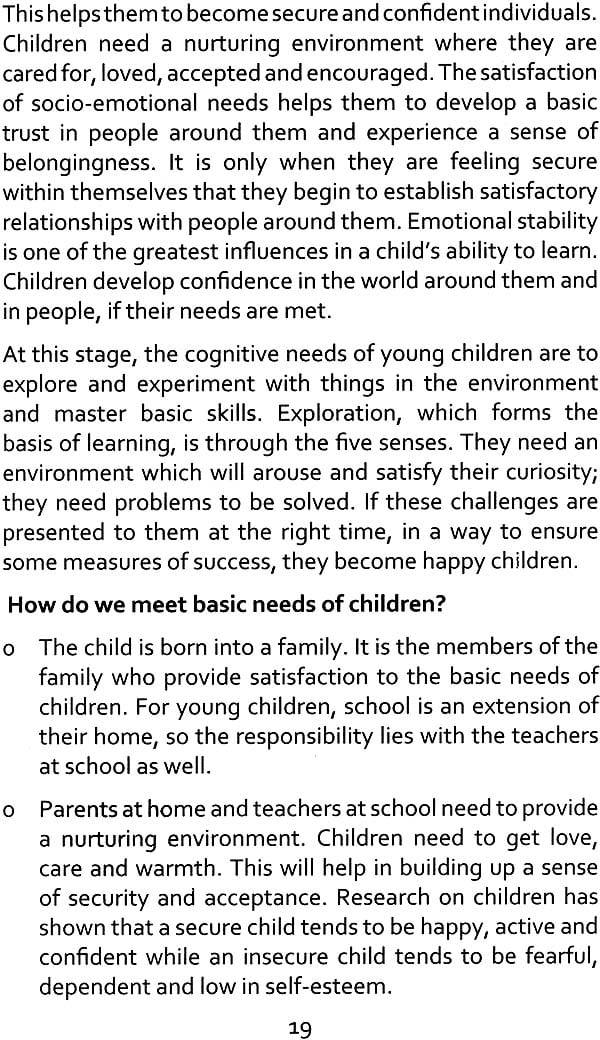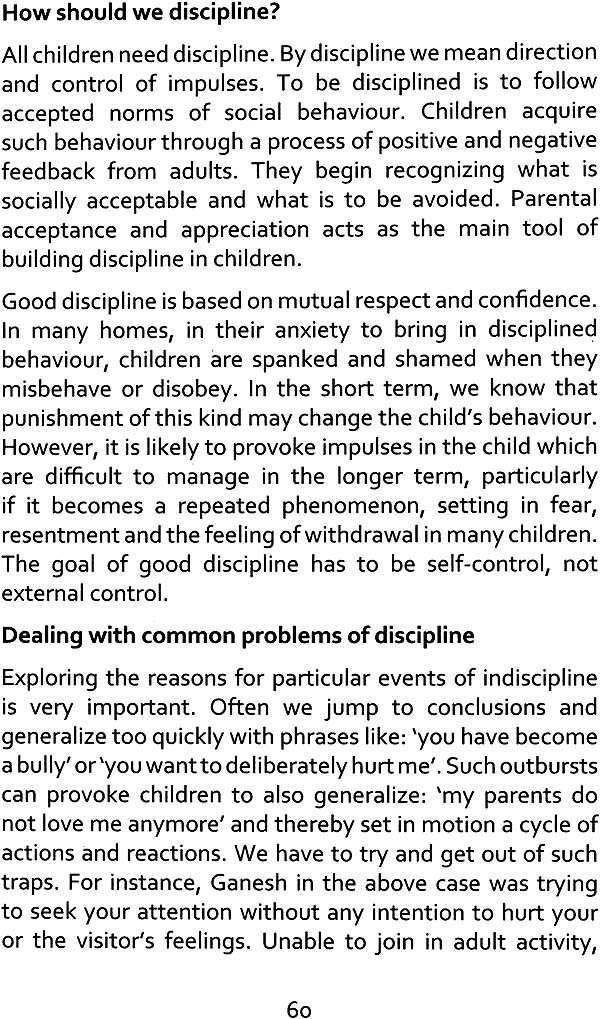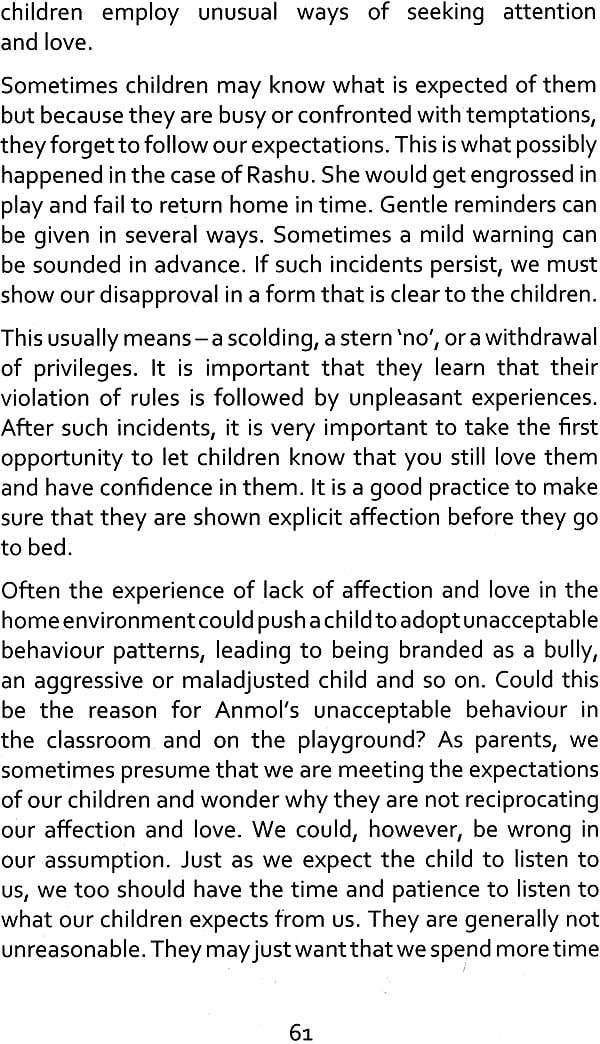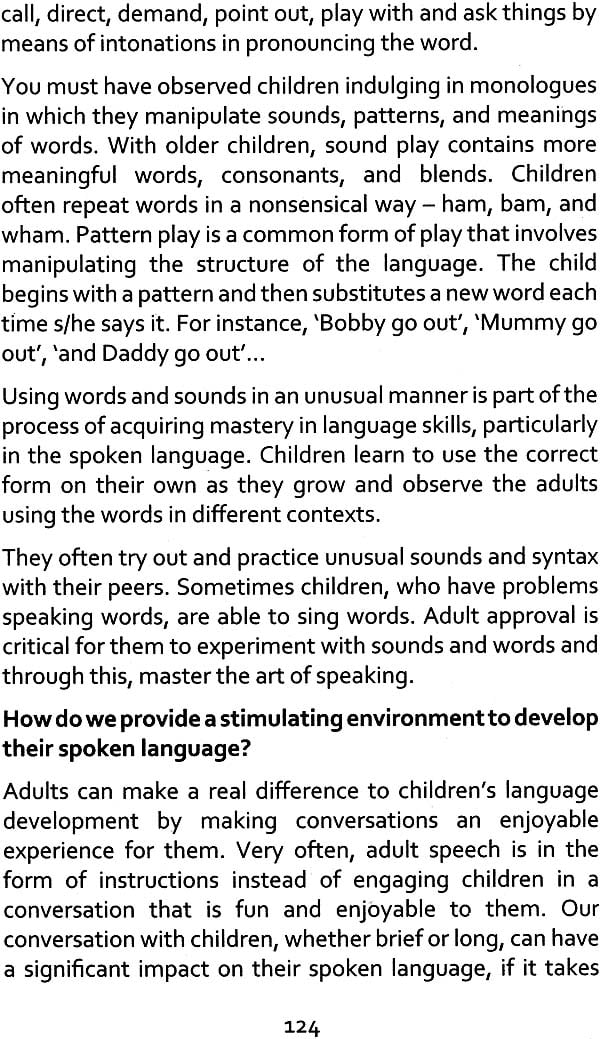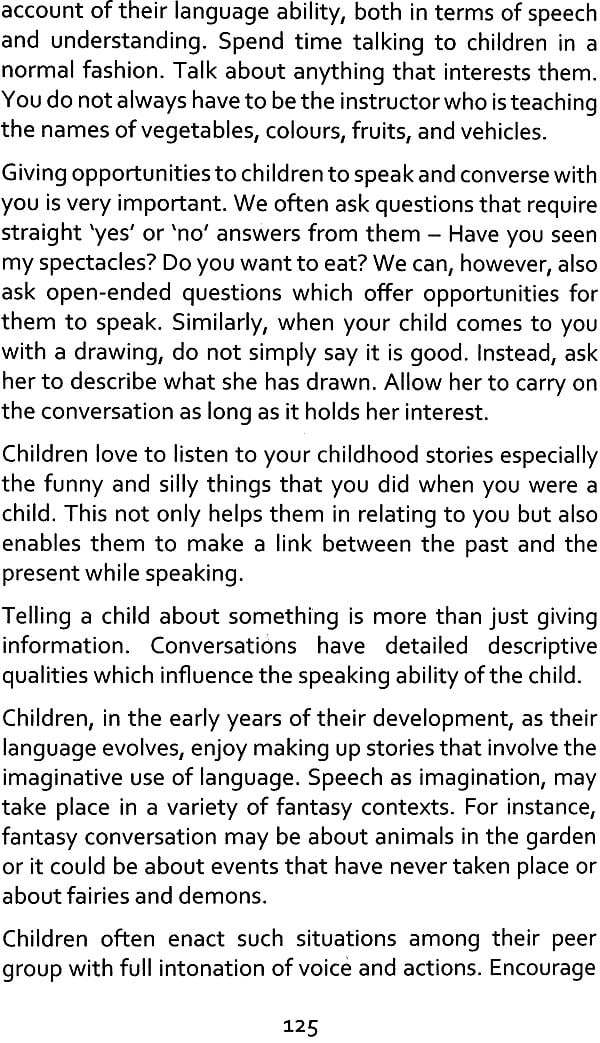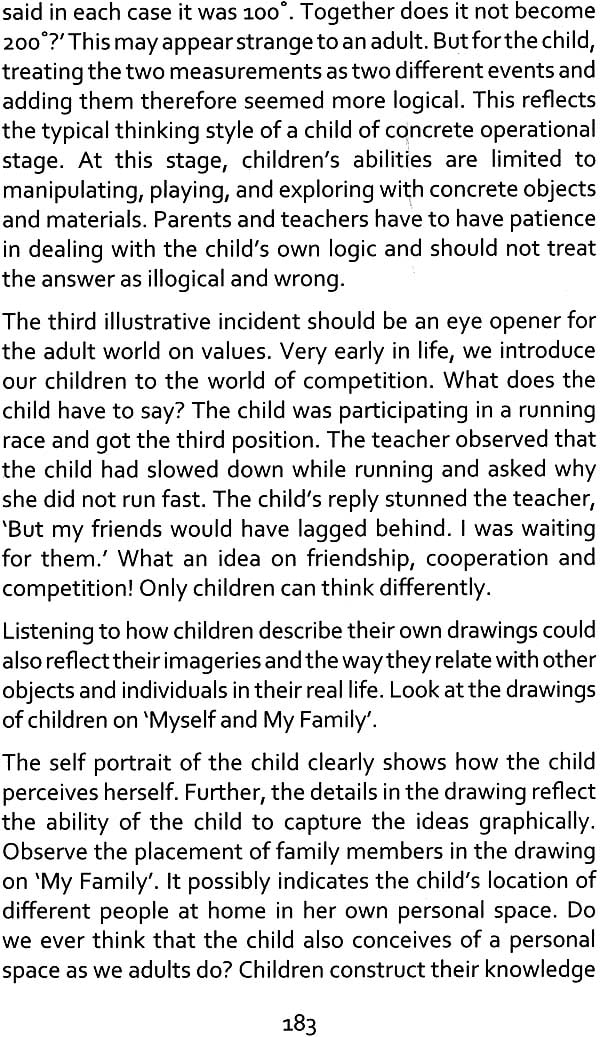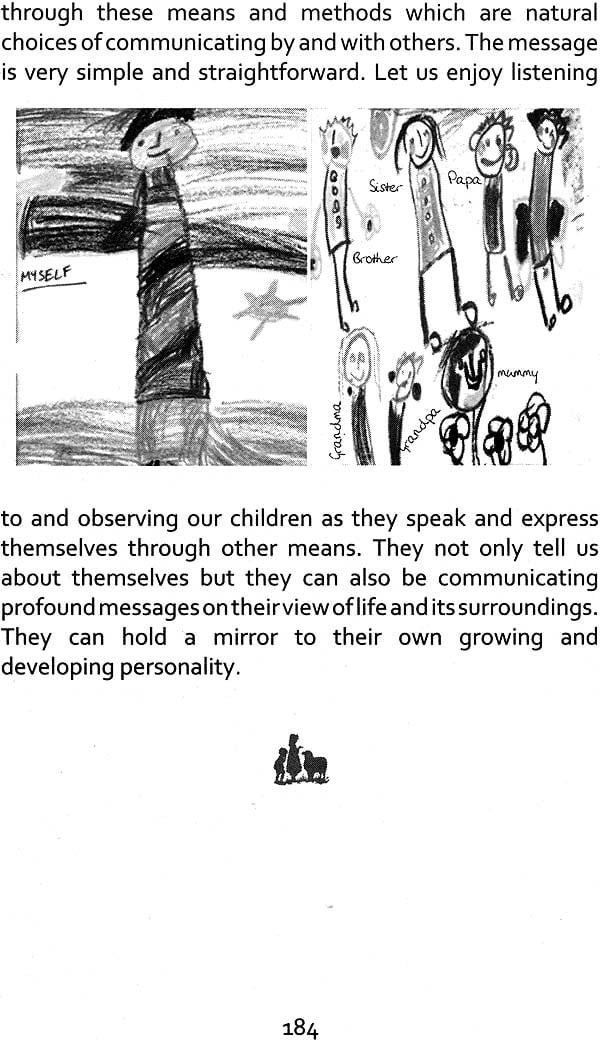
The Art of Sensitive Parenting
Book Specification
| Item Code: | NAJ510 |
| Author: | Amita Govinda |
| Publisher: | Pustak Mahal |
| Language: | English |
| Edition: | 2012 |
| ISBN: | 9788122313604 |
| Pages: | 199 |
| Cover: | Paperback |
| Other Details | 8.5 inch X 5.5 inch |
| Weight | 290 gm |
Book Description
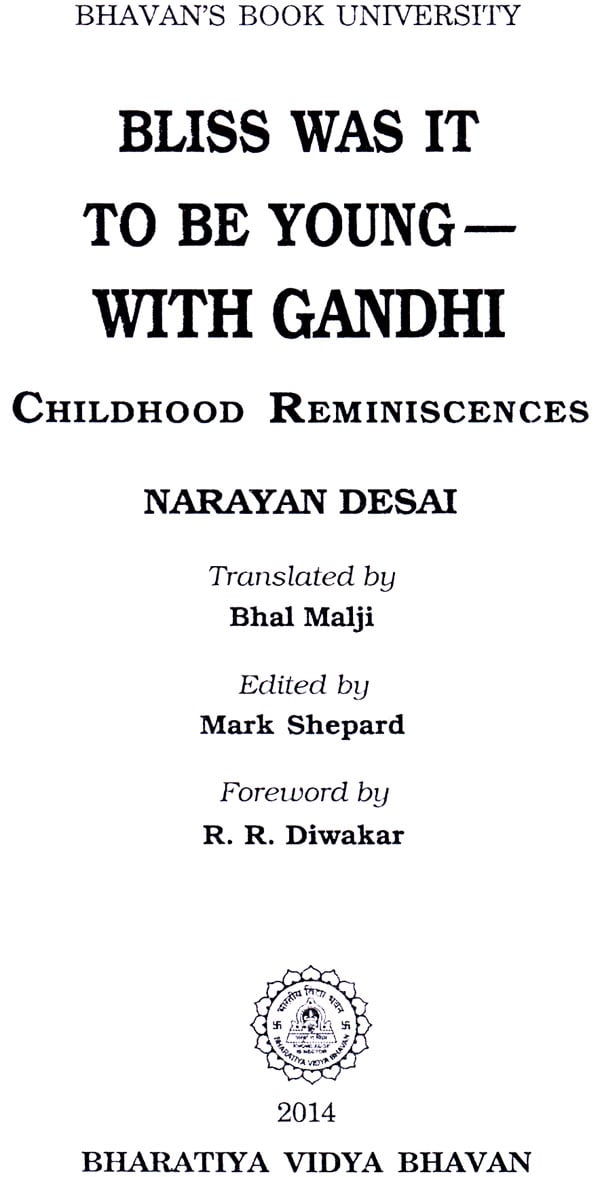
This book is about the Samvedana of parenting. Samvedana is the Hindi derivative of the Sanskrit root Sam-vedana, meaning feeling with deep sensitivity. This book uses the concept of Samvedana to underline the obligation of sensitive parenting and calls for creating an adult-child relationship of 'feeling together' in favour of the growing child. It is about exploring the physical and social/emotional world of the child with the child, in understanding the issues of child development. It opens up the child’s world to the adult, both the parent and the teacher, a world that has been little understood and much misinterpreted. In doing so, it provides simple but valuable techniques to parents and teachers in handling children in early stages of schooling.
The book is not only about the significance of sensitivity to children’s growing needs but also about growing up with children. It is about understanding their conflicts and traumas at each phase of their development and facilitating them to resolve these. It invites parents to enjoy the fascinating journey of childhood and to relive it with the growing child. It thus evokes the samvedana of parenting – to understand children’s perspectives in a sensitive manner, to listen to their side of the story, to be open to learn from them and do discover the profoundness of the inner child beyond what seems like flippant, external childishness.
The book is based on the work of the author with a number of schools and non-governmental organizations involved in implementing or promoting innovative preschool and primary education. Each issue dealt with in the book has been the subject of discussion with parents and teachers in a number of interactive sessions over the years. Many of the themes were revised based on the feedback from parents and teachers. All the ideas are based on real life experiences and personal narratives of cases from urban and rural schools with which the author has been associated over a span of more than two decades as a mentor and parents is that which has been reported to have worked well for them.
Every parent would like to see her or his child grow into a balanced person realizing her/ his full potential. Parents look for scientific but simple and easy to understand advice from real life. This is precisely what the book attempts to do- to reach out to the parents and teachers who are engaged in bringing up children. The most important characteristic of the book is its simple style and language. It avoids unnecessary theory and technical jargon and does not demand any specialized knowledge; yet, it is based on scientific evidences and has the potential to influence teachers and parents making them more sensitive to the growing child’s cognitive, social and emotional needs. Built mainly on real life cases from their own surroundings, it has ready appeal to parents and teachers alike.
Finally, the book is unique in that it explicitly links home and school, work of parents and teacher, treating child’s life space as one continuum between the home and the school. Thus, the proposed book traverses between home and school, addressing a critical group of modern parents whose children have just begun going to school. In this way, the book acts as a link between the parents and the teachers, contributing to development of a shared understanding of the challenges of dealing with the growing child. It attempts to bridge the traditional gaps in knowledge and expectations between the school and the home, which invariably affect the growth and development of the child. Yet, it is not unduly a problem-centered book; nor is it prescriptive, presenting to parents lists of dos and don’ts. It is crafted with a positive tone and language; it is more about helping teachers and parents alike to enjoy the playfulness, spontaneity and creativity of the growing child. Through this, the book tries to introduce to parents and teachers the principles and practices of ‘sensitive parenting’ or parenting with feeling.
Samvedana, is the Hindi derivative from its Sanskrit root Sam-vedana, meaning feeling with deep sensitivity. This book uses the concept of Samvedana to underline the obligation of sensitive parenting calls creating an adult-child relationship of ‘feeling together’ in favour of the growing child. It opens up the child’s world to the adult. In doing so, it provides simple but valuable suggestions to parents and teacher in handling children in early stages of schooling.
The book invites parents to enjoy the fascinating journey of childhood and to relive it with the growing child. It thus evokes the samvedana of parenting – to understand children’s perspectives in a sensitive manner, to listen to their side of the story, to be open to learn from them and to discover the profoundness of the inner child beyond what seems like flippant, external childishness, It encourages parents and teacher to be attuned to the growing child’s cognitive, social and emotional needs.
All parents look for scientific but simple and easy to understand advice from real life. This is precisely what the book attempts to do! Indeed, the most striking feature of the books is its simple style and language. It avoids unnecessary theory and technical jargon. Built mainly on real life cases from their own surroundings, it has ready appeal to parents and teachers alike.
Amita Govinda holds Master Degrees in Sociology and Education, and a Ph.D. from M.S. University of Baroda. The focus of her work for the past four decades has been on creating caring classrooms with the use of innovative pedagogies through teaching and training educators. She has conducted extensive field studies in early childhood and primary education in urban and rural areas of India. She has recently published Training Handbook and Activity Bank for pre School Education Programme.
. . .
| | Acknowledgements | 9 |
| | About the Book | 11 |
| | To Parents and Teachers | 14 |
| I.
| The Growing Child | 17 |
| 1 | The Needs of Young Children | 19 |
| 2 | Understanding the Social World of the Child | 22 |
| 3 | Let us Moke Eating Nutritious Food a Pleasant Experience For Our Children | 26 |
| 4 | Developing Independence in Children | 29 |
| 5 | Growing Up with Siblings | 33 |
| 6 | Grandparents - A Part of a Child's Life Space | 38 |
| 7 | Responding to Children's Questions | 42 |
| II.
| Nurturing the Emotional Life of Children | 45 |
| 1 | Parents in the Emotional Life of children | 48 |
| 2 | Positive Language in a Child's Life | 51 |
| 3 | How Do Our Children Learn Right From Wrong? | 55 |
| 4 | How Do We Instill Discipline inChildren? | 59 |
| 5 | Let Us Make the Child's Life Simple and Straight | 64 |
| 6 | Harmony at Home | 67 |
| 7 | Mama, Do You Still Love Me? | 71 |
| III.
| All Children are not the same: Facilitating their Development | 75 |
| 1 | Understanding the Aggressive Child | 77 |
| 2 | Can We Increase the Attention Span of Children? | 79 |
| 3 | Helping Children Who are Shy | 81 |
| 4 | Dealing with Temper Tantrums | 83 |
| 5 | How Do We Help Children with their Fears? | 86 |
| 6 | Helping Children With their Emotions through Play | 89 |
| 7 | Dealing with Leaming Disbilities: The Dhslexic Child | 92 |
| IV
| Building Creative Spaces for Children | 96 |
| 1 | Art in Child's Life: Reaching Out to the Creator of the Art | 97 |
| 2 | Rhythm and Music in Your Child's Life | 101 |
| 3 | Child's Play: Drama in Real Life | 105 |
| 4 | Do You Remember Stories that you Have Loved Hearing as a Child? Tell These to Your Children | 109 |
| 5 | Your Child is also Creative | 112 |
| 6 | Nature is a Part of the Young Child's World | 116 |
| V.
| The Learning Child | 119 |
| 1 | Developing Listening Skills in Children | 120 |
| 2 | Children Learning to Speak | 123 |
| 3 | How Do We Make Reading fun for Children? | 127 |
| 4 | Ho Do We Help children Acquire Writing? | 130 |
| 5 | What is Difficult about Learning Arithmetic? | 134 |
| 6 | Science is a Part of Everyday Life | 138 |
| VI
| Securing the Child's World | 141 |
| 1 | Protecting the Child From Abuse | 142 |
| 2 | Breaking the Barrier of Silence | 146 |
| 3 | On TV Viewing: To Watch or Not To Watch | 150 |
| 4 | Helping Children in Homes With Separated/Divorced Parents | 155 |
| VII
| Learning from the Growing Child | 158 |
| 1 | Are You A Nurturing Father? | 159 |
| 2 | Are We Consistent with Our Children? | 163 |
| 3 | What Happens to Super Kid Syndrome Children? | 167 |
| 4 | Dos and Don'ts that Shape the Personlity of Your Child | 170 |
| 5 | Dealing with the Dilemma of a Working Mother | 173 |
| 6 | Accepting and Loving Your Special Child | 177 |
| VIII
| The Child and the School | 185 |
| 1 | Your Child Goes to School: Are You Ready? | 186 |
| 2 | Danger of Pushing children in Early Years of Schooling | 189 |
| 3 | Working with children at Home | 192 |
| 4 | Is My Child Developing Alright? | 195 |
| | Epilogue | 198 |
